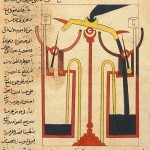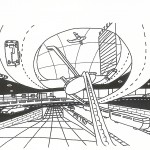
Between 1972 to 1974 three tombs in the archaeological site of Mawangdui, China, were excavated. In one of them, the archaeologists discovered three of the most ancients maps in China, contained in a lacquer box: a topographic, a military and a prefecture planimetry, oriented with south at the top. The maps, drawn on silk, display the Hunan, Guangdong and Guangxi regions and depict the political boundary between the Han and Nanyue Dynasty. The person buried in the tomb was probably a high-ranking official in the state; as his burial took place in 168 B.C. the maps must have been drawn earlier.
All three maps have been valued for their “modern” appearance: they use a planimetric projection, with the depiction tending towards conventionalization (of settlements, mountains and trees), and shows an early use of scale mapping. The scale varies between 1:150,000 and 1:200,000 in the central portion of the topographic map and between 1:80,00 and 1:100,000 in the central portion of the military map, a remarkably small scale error.
The prefecture map was in tatters when it was found and because of its conditions, its interpretation is difficult. Despite gaps, in the lower part it is still possible to recognize a city with an outer and inner wall.

Left: Han silk -prefecture-map unearthed at Mawangdui.
Right: detail (walled city)
The other two are in better conditions: the topographic map shows a complex two-dimensional graphic representation of geography (mountaineous areas, the course of rivers and county seats, these latters identified in the map) and is drawn in vegetable colors.

Topographic map from Mawangdui. Color.

Topographic map from Mawangdui. Black and white.

Reconstructed topographic map from Mawangdui.
The third map shows a portion of the terrain featured in the topographic map, specifically, part of the southermost region. This map is thought to have had military applications, since the area borders with Nanyue, a reluctant tributary state of the Han. The planimetry shows the location of army installatios and headquarters and it is notable for its use of color: military-related features, roads, and settlements are shown in red; rivers and streams in light blue-green; and other features and lettering in black. Distances between settlements, number of households and other annotations are present.

Garrison (military) map from Mawangdui

Reconstructed garrison (military) map from Mawangdui
Further reading:
Geography and Ethnography: Perceptions of the World in Pre-Modern Societies, Edited by Kurt A. Raaflaub, Richard J. A. Talbert
Via: Atlas of Affinities




Leave a Reply